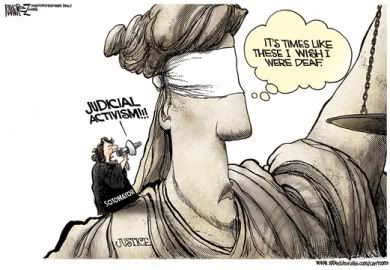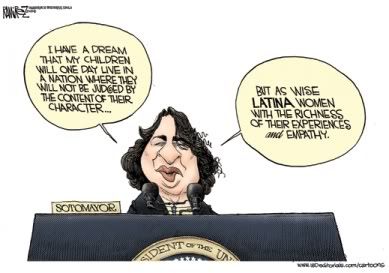Sotomayor Overruled 9-0
What's more striking is that the court was unanimous in rejecting the Sotomayor panel's specific holding. Her holding was that New Haven's decision to spurn the test results must be upheld based solely on the fact that highly disproportionate numbers of blacks had done badly on the exam and might filea "disparate-impact" lawsuit -- regardless of whether the exam was valid or the lawsuit could succeed. ...
In fact, even Justice Ruth Bader Ginsburg's 39-page dissent for the four more liberal justices quietly but unmistakably rejected the Sotomayor-endorsed position that disparate racial results alone justified New Haven's decision to dump the promotional exam without even inquiring into whether it was fair and job-related.
Justice Ginsburg also suggested clearly -- as did the Obama Justice Department, in a friend-of-the-court brief -- that the Sotomayor panel erred in upholding summary judgment for the city. (emphasis added)
The only reason Justice Ginsburg reached a conclusion on the merits is because the Court had reached an ultimate conclusion in granting the firefighters summary judgement.
Contrary to the Sotomayor-endorsed opinion, the Ginsburg dissent states (on page 19) that an employer's decision to jettison a promotional test under circumstances like this case would be legal only if the employer had "good cause to believe the [test] would not withstand examination for business necessity."
Ginsburg added (on page 26 and page 33) that "ordinarily, a remand for fresh consideration" would be proper because the lower courts (including Judge Sotomayor) had not carefully considered the evidence of "pretext" and racial politics. (emphasis added)
Even though all nine Justices and the Obama Administration were in agreement that Sotomayor should have been reversed the spin-machine has not stopped trying to paint her as a run-of-the-mill liberal judge. The following quotes represent an example of this spin.
"The main charge against Judge Sotomayor is that she will be an activist judge, but this decision clearly shows that she won't," said Sen. Charles Schumer, D-N.Y., who is part of the Democratic leadership and sits on the Judiciary Committee.
"The results in this case won't change things a wit... in fact it bolsters [the claim] that she is mainstream," Schumer added in a conference call.
"Judge Sotomayor and the lower court panel did what judges are supposed to do, they followed precedent," Leahy said. He added that a ruling for the firefighters who were suing New Haven, Conn., over their withheld promotions "would have been judicial activism contrary to clearly settled and longstanding Second Circuit precedent. The Second Circuit was bound by this precedent and not free to adopt a new interpretation of the law, as the Supreme Court has done today."
The bottom line is Sotomayor and her Second Circuit colleagues wanted to sweep the issue under the rug, refusing to even allow a trial, because it presented a difficult set of facts for them to continue advancing their preferred identity/grievance agenda. This underhanded attempt was thoroughly rejected by all nine members of the Court as well as the Obama Administration. Perhaps the best rebuttal to this incoherent nonsense put forth in her defense is the close to Justice Alito's concurrence.
Petitioners were denied promotions for which they qualified because of the race and ethnicity of the firefighters who achieved the highest scores on the City’s exam. The District Court threw out their case on summary judgment, even though that court all but conceded that a jury could find that the City’s asserted justification was pretextual. The Court of Appeals then summarily affirmed that decision.
The dissent grants that petitioners’ situation is “unfortunate” and that they “understandably attract this Court’s sympathy.” But “sympathy” is not what petitioners have a right to demand. What they have a right to demand is evenhanded enforcement of the law—of Title VII’s prohibition against discrimination based on race. And that is what, until today’s decision, has been denied them. (emphasis added)
Update: RCP links to Ed Whelan who echoes the points I make above.




